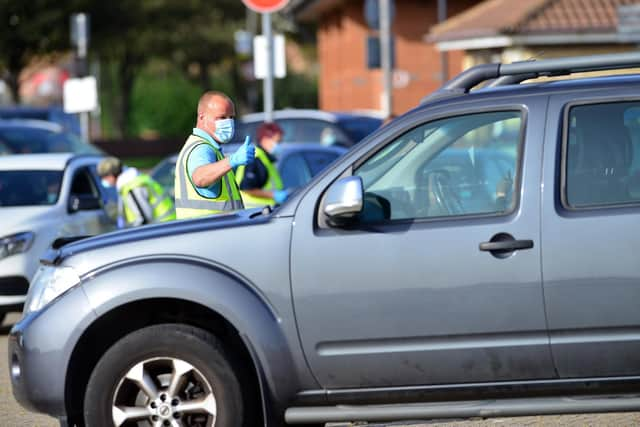North East's plight under covid mirrors its suffering during Spanish flu pandemic
and live on Freeview channel 276
The region has at times had some of the worst infection rates in England, and is under Tier 3 covid restrictions – the highest level of regulations limiting social mixing, meaning pubs and restaurants must remain closed and households cannot mix indoors or in private gardens.
A recent study by the Northern Health Sciences Alliance (NHSA) found the Northern Powerhouse area suffered over 12 more Covid-19 related deaths per 100,000 than the rest of England.


Advertisement
Hide AdAdvertisement
Hide AdNow one of the authors of that research has analysed the 1918 Spanish flu outbreak, which killed 50-100 million people globally, for any health inequalities.
Clare Bambra, professor of public health at Newcastle University, teamed up with other academics - including Dr Paul Norman from Leeds University - to study similarities in how the two quite different pandemics affected England's regions.
She told the PA news agency: "We looked at data from the 1918 Spanish flu pandemic and mapped it to see what happened in different local areas at that time.
"We found that, similar to today with Covid, there was much higher mortality from Spanish flu in the northern areas of England, and the Midlands.
Advertisement
Hide AdAdvertisement
Hide Ad"The lowest rates were in places like Surrey - around 200 deaths per 100,000 in 1918 - and the highest rates were up in places like Hebburn and Jarrow in the North East, where it was almost 1,200 deaths per 100,000.
"So six times as high."
The data was sourced from the 1920 report into the Spanish flu pandemic's mortality rate compiled by the Registrar General - the equivalent of today's head of the Office for National Statistics.
Writing at the time, Sir Bernard Mallet said: "The northern parts of the country suffered decidedly more, on the whole, than the southern."
Prof Bambra said the same was true a century later, despite the creation of the welfare state and the NHS in the intervening time.
Advertisement
Hide AdAdvertisement
Hide AdShe said: "Covid rates are much lower across the whole of the country, thankfully, than the pandemic flu rates 100 years ago but we still find big differences.
"For example, in the NHSA report, we found that mortality in the first wave of Covid was around 12 deaths per 100,000 higher in the Northern Powerhouse than in the rest of England."
Prof Bambra, who has written a paper published in the journal Environment And Planning A: Economy And Space, said it was too early to directly compare the towns worst affected by Spanish flu and the areas most hit by Covid.
But she said it was clear that Northern regions did worse in the 1918 outbreak and were doing worse in 2020 with Covid.
Advertisement
Hide AdAdvertisement
Hide AdShe said: "The degree of inequality is smaller today, but the background factors are still the same.
"It has to do with social and economic inequality.
"Inequality in people's working conditions, in their standards of living, in people's nutrition and in the underlying risk factors, such as diabetes or Chronic Obstructive Pulmonary Disease."
The public health expert said this was not inevitable.
"I don't think it needs to be accepted," she said.
"There is evidence from other countries that you can really close regional inequalities in health.
"So for example, East and West Germany had a four year gap in life expectancy at the fall of the Berlin Wall.
Advertisement
Hide AdAdvertisement
Hide Ad"Today there is no gap in life expectancy between these two parts of the country.
"The differences are now such that women in the North East or North West of England have a lower life expectancy than women in the east of Germany.
"So if they can do it there, under much harder circumstances, there is no reason why we cannot level up here."
Commenting on the research, Jamie Driscoll, Labour's North of Tyne elected mayor, said: "There's a direct link between economic security and health. It's been proven time and again.
Advertisement
Hide AdAdvertisement
Hide Ad"Most recently the Marmot report showed the North East has sections where life expectancy is falling.
"Healthy life expectancy is much lower than other parts of Britain.
"In the past we might have said it's the nature of the work - the link between mining and lung disease, for example.
"But the plain and simple fact it's because of poverty and insecure work."
Advertisement
Hide AdAdvertisement
Hide AdA Government spokesperson said: "We remain determined to level up on health outcomes as well as opportunity, with our £30billion Plan for Jobs helping create, protect and support across the UK.
"We have also committed £170million to help families stay warm and well fed this winter while our Universal Credit increase has resulted in millions of people receiving more money than previously.
"Throughout the pandemic we have worked hand-in-hand with local authorities and over £300m has already been allocated to local authorities in England to help them stop the spread of the virus in their communities."
You can subscribe to this website and enjoy unlimited access to local news, information and puzzles online. With a digital subscription, you can read more than five articles, see fewer ads, enjoy faster load times, and get access to exclusive newsletters and content. Simply click ‘Subscribe’ in the menu.